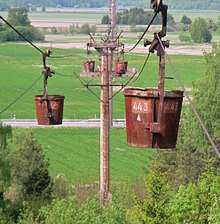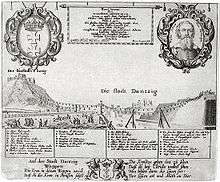Material ropeway
A material ropeway or ropeway conveyor[1] is essentially a subtype of gondola lift, from which containers for goods rather than passenger cars are suspended.


Material ropeways are typically found around large mining concerns, and can be of considerable length. The COMILOG Cableway, which ran from Moanda in Gabon to Mbinda in the Republic of the Congo, was over 75 km in length. The Norsjö aerial tramway in Sweden had a length of 96 kilometers.
The first recorded mechanical ropeway was by Croatian Fausto Veranzio who designed a bicable passenger ropeway in 1616. The world's first cable car on multiple supports was built by Adam Wybe in Gdańsk, Poland in 1644. It was powered by horses and used to move soil over the river to build defences.[2]
In Eritrea the Italians built the Asmara-Massawa Cableway in 1936, which was 75 km long. The Manizales - Mariquita Cableway (1922) in Colombia was 73 km long.
Conveyors can be powered by a wide variety of forms of energy, electric, engines, or gravity (particularly in mountainous mining concerns, or where running water is available).[3] Gravity-driven conveyors may qualify as zip-lines.
See also
References
External links
- La Teleferica Massaua-Asmara (pictures of Ethiopian Ropeway) www.trainweb.org
- Conveyor & Ropeways Services Pvt. Ltd. www.crspl.com
- Low-tech Magazine: "Aerial ropeways: automatic cargo transport for a bargain"